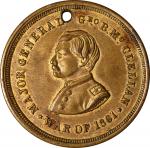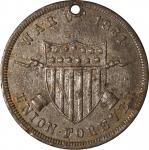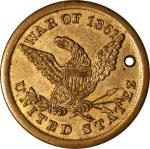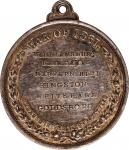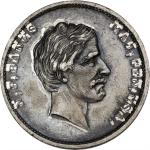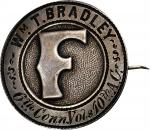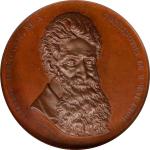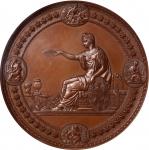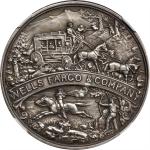1862 Hunt & Nash (Irving House). Thirty Cents. HB-159, EP-180, S-112, Reed-IH30. Extremely Fine, Cleaned. <strong>Case:</strong> Minimally worn with all major features on the back sharp, although both sides exhibit light hairlines and a curiously bright brassy-gold color from a cleaning. There are, however, no sizeable marks or other blemishes. <strong>Mica:</strong> Fully intact and generally smooth with only a few subsurface laminations at the lower left. Minor scratches are evident upon close inspection with a loupe, but are hardly distracting in hand. <strong>Stamp:</strong> Faded salmon-pink color, yet quite smooth. It is centered high in the frame with the upper legend mostly lost to view.<p>During the severe shortage of small change in New York City during the Civil War, several hotels resorted to the expedient of having cardboard chits printed for the convenience of their customers. Typically, these chits were rectangular in shape and were denominated in one cent, five cents, ten cents and other low values. Among such issuers were the Washington House, Market House, and Putnam House establishments. Only one, however, Irving House, also commissioned encased postage stamps from John Gault.<p>The Irving House was located at the corner of Broadway and 12th Street, a fashionable address then as now. Broadway was New York Citys main thoroughfare. Two blocks north lay the park that would later be named Union Square, while an equal distance south along Broadway was Grace Church and School, the first a perambulatory for New Yorks social elite, the other one of the more prestigious schools for their young. The hotel had been named for Washington Irving and earlier had been graced by the "Swedish Nightingale," Jenny Lind, who stayed there during her triumphant American tour under the auspices of P.T. Barnum in 1850.<p>The Irving House advertised on its own encasements that it offered the "European Plan" for its guests. Under this arrangement, the hotel charged its customers a flat rate for their rooms, and all other services were at an additional charge. This plan, first practiced in Bostons Tremont House, was advertised as being cheaper than the "American Plan," under which room, board, and services were all included in a single rate per day. In actuality, it was not cheaper, and its implementation at Bostons Tremont House and New Yorks Irving House hotels made them more profitable than their competitors.<p>George W. Hunt was the proprietor, and he oversaw the hotels daily operations. Charles W. Nash was in charge of the food and catering services. This division of responsibility seems to have been typical of the better hotels of the day; it also characterized the arrangement that George Gage made with John Drake in Chicagos Tremont House. The Hunt & Nash partnership lasted until 1863, when Nash left to open a restaurant. Hunt stayed on until 1869, when he sold his interest to George Harlow. By that time, however, Irving Houses glory days were over. The hub of New Yorks social scene had moved farther north along Broadway, leaving 12th Street and the Irving House behind.<p>The Irving House encasements are slightly different from others in the series. In the first place, Gaults patent notice is larger than on any other encasement, including Gaults own. Second, the border around the back was not beaded, while the borders of all other encasements (excepting Gaults own and Browns) were beaded.<p>Encasements from this commissioner are known in the one cent through thirty cent denominations. The majority are extremely rare. All save the last are also known in either plain or ribbed frames and, surprisingly, the most available varieties are in ribbed frames: the five cent and ten cent pieces.<p>The present offering is for an exceedingly rare Hunt & Nash thirty cents encasement. This variety is listed, but not priced, in the1989 Hodder-Bowers reference on encased postage stamps. The newer reference <em>Civil War Encased Stamps</em> (1995) by Fred L. Reed assigns a rating of Rarity-10 with the comment "Unique." This is presumably a newcomer to the census, and its offering in this sale represents what could very well be a once in a lifetime bidding opportunity for the specialist.


